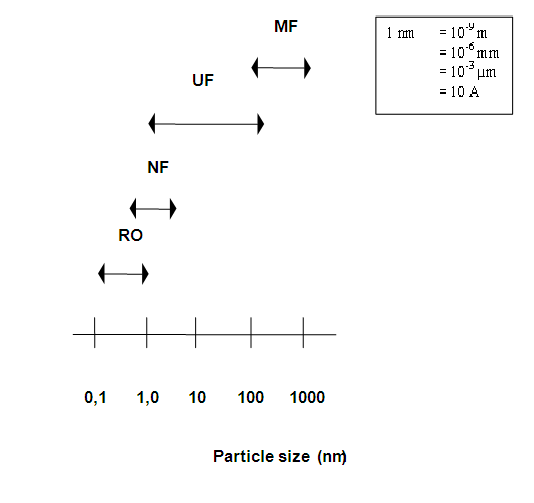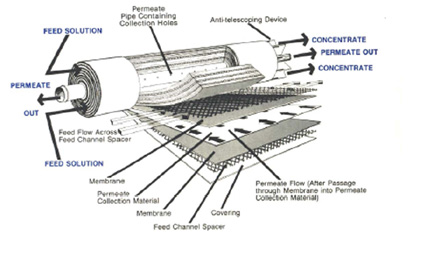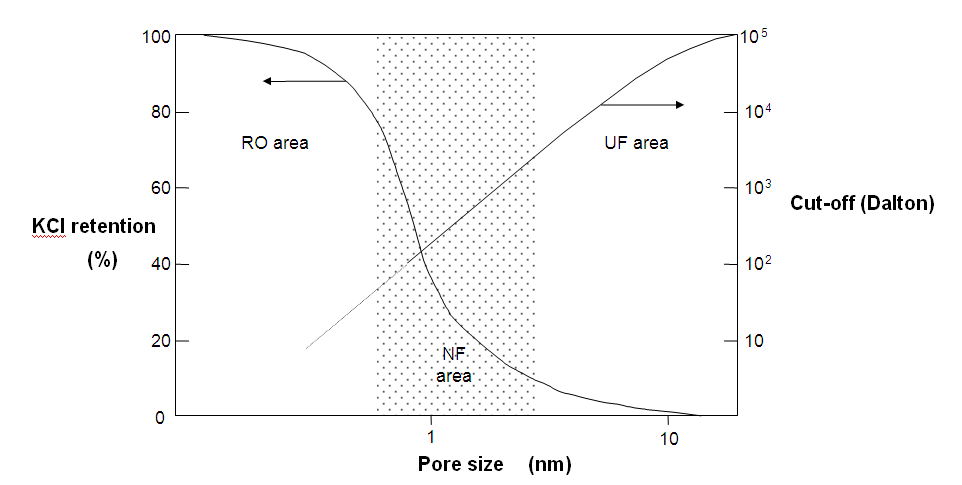Method diagram

Method and installation description
Nano-filtration (of NF in short) is a pressure-driven membrane process which, in terms of separation level, lies between ultra-filtration and reverse osmosis.
As micro-filtration and ultra-filtration, the sieve effect is one of the separation principles, as are solvent diffusion and electrostatic repulsion. The sieve effect is based on the difference between the particle size and the pore diameter. The pore size of the nano-filtration membrane is characterised by a cut-off value. This cut-off value is consistent with the molecular weight of the smallest molecule that can be 90% restricted by the top layer of the membrane (2 µm thick). The cut-off value is expressed in Dalton (Dalton = weight in grams of mole of the molecule). A typical nano-filtration membrane lies in the range of 150-500 Dalton, depending on the molecular structure.
Nano-filtration membranes possess pores with a size of approximately 1nm. Nano-filtration membranes are characterised based on their retention[1] of loaded and unloaded particles. The retention of a nano-filtration membrane can be determined via experimental filtration tests with pre-selected molecules. A simple salt solution (NaCl or Na2SO4) is selected for loaded particles. Polysaccharides (dextrines) or polyethylene glycols (PEG) with various molecular weights are selected for unloaded particles. The salt retention of a typical nano-filtration membrane is considerably lower than, for example, reverse osmosis, while salt retention is zero for ultra-filtration.
A nano-filtration membrane is also ion-selective. This is the ability to distinguish various ions from one another. Because a nano-filtration membrane collects solid loaded groups in its membrane structure, electrostatic repulsion/attraction forces may occur between the components in the liquid and the (nano-filtration) membrane surface, which results in a certain degree of ion selectivity. Based on the sieve effect (pore size 1 nm) and the molecular size of chlorides (0.12 nm in size) and sulphates (0.23 nm in size), these ions are expected to diffuse through the membrane. Despite this, the retention for chlorides is maximum 90 % and that of sulphates is minimum 90% (also see effectiveness paragraph).
A nano-filtration membrane can be tubular, spiral or flat in shape. A spiral module (see figure below) consists of polyamide membrane layers wound in spiral form. At the edge of the membrane, the wound layers are sealed using a cap. A permeate collection tube is located in the centre of the wound module. All the clean water is passed through the spiral windings and collects in this tube.

Specific advantages and disadvantages
Here are a few specific advantages and disadvantages of NF:
Advantages:
- Lower discharge volumes, lower retentate concentrations than RO for low value salts;
- Reduction salt content and dissolved matter content (TDS) in brackish water;
- Reduction in heavy metals;
- Reduction in nitrates and sulphates;
- Reduction in colour, tannins and turbidity;
- Softens hard water when specific softening membranes are used;
- chemical-free, e.g. needs no salt or chemicals during operation;
- pH of water after nano-filtration is normally non-aggressive;
- Disinfection.
Disadvantages:
- Higher energy consumption than UF and MF (0.3 to 1 kWh/m³);
- Pre-treatment is needed for some heavily polluted waters (pre-filtration 0.1 - 20 microns). This is always the case with spiral-wound membranes.
- Limited retention for salts and univalent ions.
- Nano-filtration membranes are a little more expensive than reverse osmosis membranes;
- Membranes are sensitive to free chlorine (life-span of 1000 ppmh). An active carbon filter or a bi-sulphite treatment is recommended for high chlorine concentrations.
Application
Well known uses of NF include water softening and the removal of pesticides from wastewater.
Nano-filtration membranes can primarily be used to remove multivalent ions and smaller organic molecules from water.
Boundary conditions
Nano-filtration has stricter supply water requirements than, for example, UF or MF, but not as strict as reverse osmosis. The quality of supply water must comply with the requirements of the membrane supplier, according to the accompanying technical information sheet. Here are a few examples:
- Maximum 0.5 ppm Fe/Al/Zn/Mn;
- SDI value of water for SDI15500 < 5;
- No free chlorine present in the supply water (resistance only 1000 ppm hours free Chlorine, or max 0.1 ppm free chlorine);
- Maximum water temperature of 40-50 °C;
- Maximum operating pressure 45 bar;
- pH range 3- 10, during cleaning pH transitory 2-12 (always consult the technical notes or the supplier).
Effectiveness
Micro-pollutants like herbicides and insecticides, as well as low-molecular components like colorants and sugars can be very successfully blocked using a nano-filtration membrane.
NF can be implemented for removing the following parameters (removal yield indicated in brackets):
- Dissolved matter (>75%);
- Harmful micro-organisms, e.g. bacteria, protozoa, algae, fungi (>90%).
- Persistent organic matter (50-75%);
- Organic compounds (50-90%);
- Nutrients (incl. phosphates);
- Metals (50-90%).
- Inorganic salts (e.g. sulphates).
The operating range of nano-filtration lies between that of reverse osmosis and ultra-filtration, as shown in the figure below.

Environmental issues
In nano-filtration, both ions are normally concentrated in a watery flow – the retentate. This flow is a thickened version of the supply flow. Thickening is determined by the desired permeate quality, the design of the installation and the retention of the membrane.
The concentrated flow must be discharged (after purification) if it cannot be put to good use in the process. When discharging, the discharge norms in the permit must be compared with the quality of the concentrate.
Costs
A nano-filtration installation for the production of 100 m³/h permeate, approximately costs between € 300.000 and 350.000. This would be for the following process configuration:
- 2-step design;
- Recovery 75 %;
- CIP tank;
- Average energy consumption of 25 kW for 1st step, 7 kW for the 2nd step;
- 76 NF membranes;
- 2-1 configuration consisting of 6 pressure pipes for 1st step and 3 for the 2nd step;
- 54 membranes in 1st step, 18 membranes in 2nd step;
- Nominal salt retention 30-85%;
- Working temperature 15-30°C;
- Inflow pressure pump 3 -6 bar;
- Design temperature 25°C.
Comments
/
Complexity
/
Level of automation
More than 95% of an NF installation can be automated. For example, the cleaning process can be fully automated. However, manual intervention is still needed to replace membranes.
References
- EIPPCB, Reference Document on BAT in Common Waste Water and Waste Gas Treatment / Management Systems in the Chemical Sector, draft February 2009 (revision upon release)
- Manual of Effluent Process Technology, Environmental & Process Engineering Department, AEA Technology, Harwell (GB), 1991
- Mulder M., Basic Principles of Membrane Technology, Kluwer Academic Publishers, Dordrecht (NL), 1996.
- Dutch Membrane Guide, version 2.0, 1996
- TNAV, supplier survey, 2008
- Van der Bruggen B., Schaep K_J., Vandecasteele C. and Wilms D., Nano-filtration, Water treatment for the 21st century, in the Ingenieursblad, October/November 1999
- VITO-SCT, revision of technical notes WASS, 2008
- Wang Z., Liu G., Fan Z., Yang X., Wang J. and Wang S., Experimental study on treatment of electroplating wastewater by nano-filtration, J. Membr. Sci. 305 (2007), pp. 185–195, 2007
Version February 2010
[1] Extent to which the particles are blocked by the membrane.

